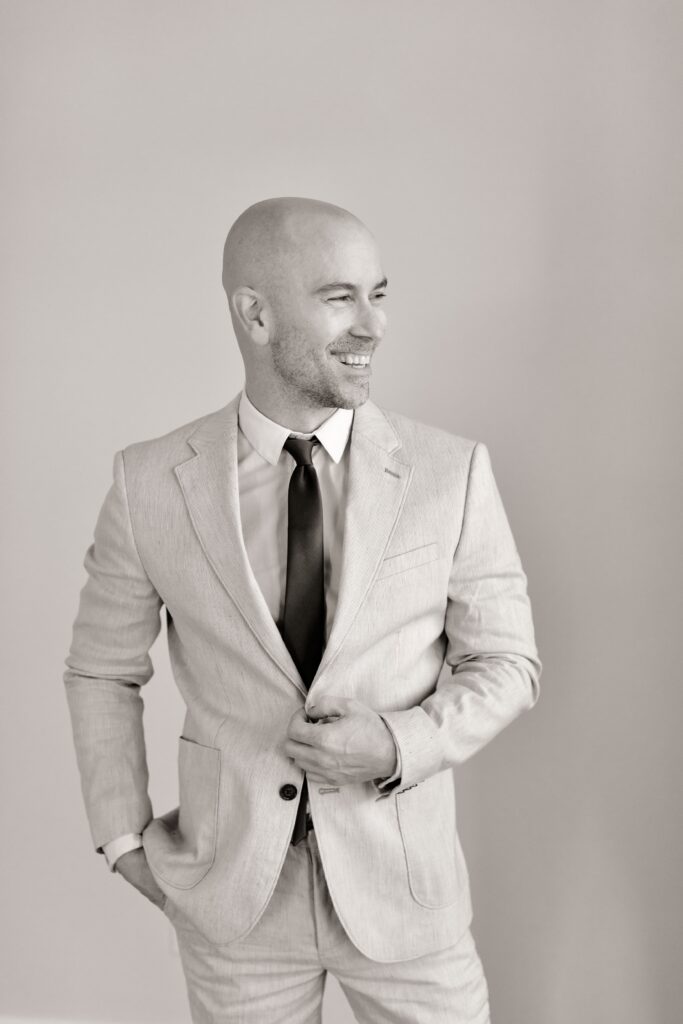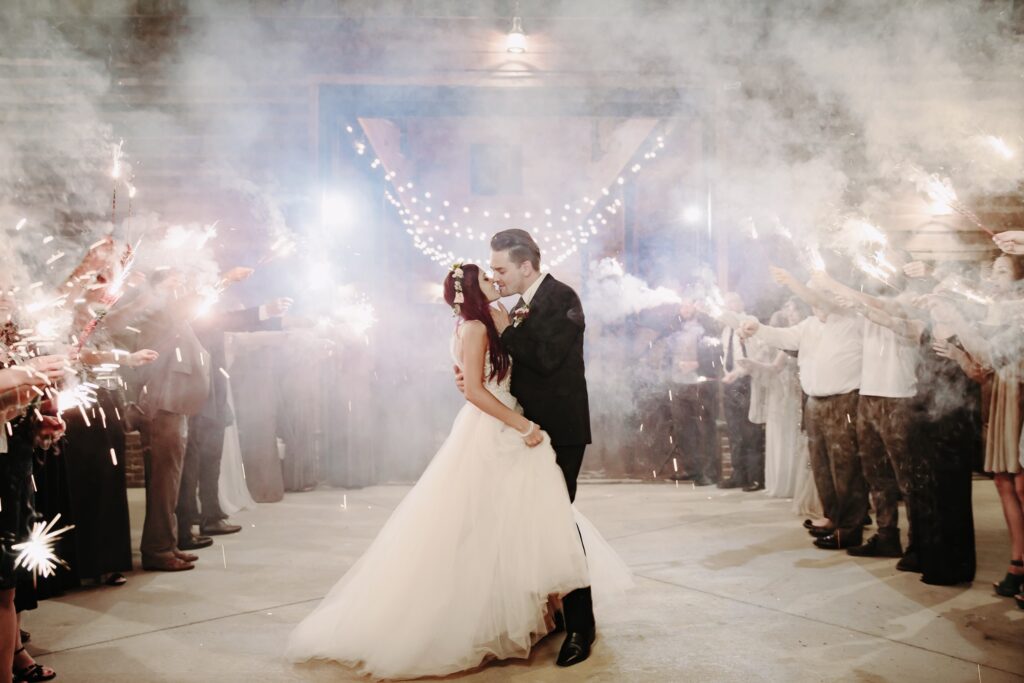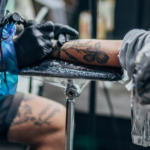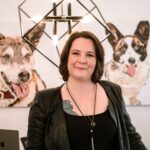Zach Gray has been a professional photographer and business coach for photographers for over 14 years. After building his business to over 6 figures in less than a year, he turned his attention to helping other photographers succeed by being as good at business as they were at taking pictures. And while Zach Gray has photographed celebrity weddings that have been Featured in People Magazine and Southern Weddings Magazine, he is proudest of the work he has done helping photographers meet their business goals.
In this episode we talk about how Zach learned to get his wedding photography business booked solid in one year. He has a number of helpful tips and tricks that would work in any industry.
As usual, find the link to your podcast service of choice and a full transcript below.
Listen on:
Follow PocketSuite:
Follow Zach Gray:
Photography Business Mentorship
Full Transcript of Booked Solid Episode 7: Closing the Sale with Zach Gray

PocketSuite:
Thank you again for joining us on the Booked Solid Podcast, a place for anyone with clients. Today we have Zach Gray. He is a pro photographer and a coach that helps other photographers achieve their dreams and get to that six figure salary. Thank you so much for joining us today, Zach.
Zach Gray:
Hey, thanks so much for having me on. I’m really, really stoked to be here with you guys.
PocketSuite:
Thank you. You started in the photography world with your own business 14 years ago. Can you tell us a little bit about how you got started in this business?
Zach Gray:
Well, yeah. When you asked me that question, I kept saying, “14 years,” and then I actually did the math again and I’m like, actually it was 16 years ago, so it was 2006, 2007. I was a touring musician. So I have this really odd story. A lot of people have heard this, but this was sort of in the era of when I was this really popular wedding photographer back in like 2010, ’11, ’12, ’13. And I have this very in unusual story of being this poor kid from Northern Minnesota who only has a third grade education and got my GED when I was 21 and thought I was an idiot and never thought I was going to succeed in anything and was only good at one thing, which is playing these guitars hanging on my wall. And I moved to Nashville touring with an artist here on a label making a thousand bucks a month and I thought I was rich because I’d never made that much money in my life and didn’t realize $12,000 a year was actually way below the poverty line and I had no clue.
And then I got married in 2005 and my wife was super smart and educated and a 4.0 college grad. And I had this crazy idea to get off the road and start a photography business. And she was like, “You could totally do that.” And nobody in my life had ever thought that I was capable of doing something. So we started this photography business and I thought, we just got married so weddings, there’s money in weddings. People spend a lot of money on weddings. I thought that makes sense. It’s creative and artistic, which are two things I love with music, so photography scratches that itch for me. And from June of 2007 to December of 2007, I shot 19 weddings and thought we were crushing and killing it and this was amazing. And then at the end of it, we did the math and realized we only made $4,000 in profit of doing half a year’s work.
And I was like scratching my head like, “Oh no, this is not good. What is missing?” Because after shooting 19 weddings I thought, “The photography’s getting there. I think the photography’s good. Why are people not spending enough money to make this profitable?” And then this crazy thing occurred to me that I actually knew nothing about how to run a business. And once I realized that, I went into business mode and I went, “Okay, I got to figure out how to run a business.” I started taking out friends who I knew were making a lot of money and asking them, “How do you make money?” Instead of saying, a lot of us photographers go, “How do you take really awesome photos? How do you get that cool lighting on your shot?” I said, “How do you actually make money?” And I was surprised at what everybody said.
They didn’t talk about the quality of their photographs. They started talking about creating an experience for their customers and doing something special and unique and all these things that I had never heard about. So then I started reading all these business books. I read like 10 business books over the winter of 2007. Had a new business plan in January of 2008, which was in five years I want to make a six figure income, which to me was outrageous. That was a huge goal for me because I’d never made more than $12,000 in a year. And in five years I wanted to do that. And here’s my new business plan. And I created this whole thing that I was going to do. Launch, relaunch the business in January of 2008, and by February had made six figures in 60 days. And when that happened, I just went, “I got to tell everybody I know how to do this.”

PocketSuite:
All right. What did you change? What happened differently from those 19 weddings before to however many weddings you did after that made it from like $4,000 in profit to a hundred thousand?
Zach Gray:
Well, I read this book, we talked about this off camera. I read this book by Michael Gerber called The E Myth. And in the E Myth stands for the Entrepreneurial Myth, Why Most Small Businesses Fail. Because 94% of all small businesses within 10 years in America fail, 80% in the first five years. And the reason for that is because a franchise has a model that knows how to attract a customer, how to price for profit, and how to take care of that customer, how to manage them well, and then how to execute. So he calls it the entrepreneur, the manager, and the technician. And I realized I was actually only good at one thing, the technician, technically taking nice looking photos. That’s the only thing I knew how to do. I didn’t know how to manage a customer’s expectations. And in this day and age, if all you do is manage their expectations, big deal. They expect you to do that. They expect you to take good pictures. They don’t expect you to take bad pictures. They expect amazing photos. They expect amazing client service. But what else do you have?
And that’s what the book talked about, which is we actually live in something that Tim Sanders calls the experience based economy. People will pay a premium. You want to make more than average? People will pay a premium for how they feel about the experience, how they feel when a bride opens up a wedding album and the story is unfolding in front of her, and you help tell that story. It’s not about the quality of the pictures, it’s about the storytelling. So when we switched from, I want to take really good pictures as a photographer to, I want to create a great experience, I want to tell amazing stories that matter, I want to talk about the emotions of what all of this means and happen to take good photos and manage my customers well, every partnership that I built, every person that I started working with went crazy about this experience we had created and it spread like wildfire.
Before I knew it, I had so much work, I didn’t know what to do with it all. And I started referring it to my friends and they were referring it back to me when I wasn’t booked and the business just exploded. And that was the difference, was understanding that people pay a premium for how they feel, not for just high quality.
PocketSuite:
Okay, walk me through that for a minute. One of the first weddings that you did where you were focusing on how your client felt, what did you do to make it into an experience for them rather than just buying pretty pictures?
Zach Gray:
So I think the first thing was realizing that one, I have to have the right lead. So there’s a sales process I use which is from Dave Ramsey’s book, Entree Leadership. It’s called qualified, rapport, educate, close. And if you walk through those first three stages, everybody closes. And I learned this from him back in early 2008. And he says step number one is you have to have a qualified lead, somebody who understands what you do and why you do what you do. They want to buy into it. So qualifications are things like, can they afford it, whatever my price is? And I decided to set my prices above average because I wanted to say something with the pricing that this is not average photography, it’s above average. And price alone is one step to say that.
So qualification based on price, qualification based on interest, qualification based on need. Did they have a need for my service? They’re getting married at say in weddings. Can they afford it? I actually put in my contact form, what’s your photography price point range. And I noticed this trend, if it was within 25% above or below, they were qualified. If it was more than that, once you hit over about 35%, which when you learn about pricing strategy and the pricing bell curve, you realize it becomes very hard to create enough value to move up 50% in price. Doesn’t matter how great the thing is, it’s really hard for you to move. So if I believe I’m going to spend two grand, but it costs three plus thousand, it’s really hard for me to make that jump. So that was another qualifier.
Another qualifier I put in my contact form was, on a scale of one to 10, how excited are you for Zach to shoot your wedding? I never booked anybody that was below an eight. If they didn’t put eight or higher, they were just price shopping or they had just Googled and I was on the first page of Google. They didn’t hear about me from a referral source. They didn’t hear about me from one of my partners, which is one of the most important things to build on beginning of your business is partnerships. They didn’t come from a partner, they came arbitrarily, and now I’m trying to win them instead of them already being warmed up and becoming a warm lead for me. So step number one, qualified.
If I get a good qualified lead and they come and sit with me, the next step is rapport. And rapport building is everything here. It is everything to do with this, Dale Carnegie, How To Win Friends and Influence People, which means it’s all about them. Has nothing to do with you. People are not interested in you. People don’t care about your story. People don’t care about how good your pictures are. They care about themselves, and not in a selfish way, but in the sense of, “I’m going to come spend money in here. What is the return I’m going to get on my investment for this? How is this going to impact my life?” So the goal of rapport building is very simple, I have to talk about them and find out what makes them come alive. So when I would sit with somebody in a meeting, on the phone, or preferably in person, Dale Carnegie says, “Step number one, smile.” You can’t make this sound without smiling. So we got to smile. We got to be genuinely interested. This is my favorite quote of all time from Dale Carnegie. He says, “You can win more friends in two months by becoming genuinely interested in other people than you can in two years trying to get other people interested in you.”
So I took that ideology and I said, when I sit down with a bride, I need to be like this, “Tell me your story.” And they would go, “My story?” Because I’d like to use a question that’s sort of unusual to make them think. And they’d go, “What do you mean?” I’d go, “I don’t know, what matters to you?” And usually whatever they started talking about was something that was important. So maybe they would say, “Well, I went to the University of Tennessee.” And I would go, “What’s your major?” Follow up questions, genuine interests, and just ask about them. All that to say is you build this rapport by becoming genuinely interested in other people, using their name, which is the sweetest word in the English language. They say, write your own name. Using their name, asking them questions and building to a point of step number three, which is education.
So then in the education process, it’s very simple. Most photographers will take out a book or they’ll talk about their cameras or they’ll talk about, maybe if they do albums, they’ll say, “My albums are printed on Kodak Endura paper and it’s a leather cover.” And clients don’t care about any of that stuff. But what I would do instead is I would say, “Well, thanks so much for sharing all that with me. Let me tell you about what I do.” And then I would have my wedding album, a 78 page wedding album, sitting in my lap with my fingers stuck in a page. And I would tell them a story because photographers are storytellers. That’s what we do. We get to tell stories. So we need to learn how to tell our own stories really well. And I would tell the story of Steven and Scarlet, which is the album. I only had one album. That’s the only album they ever saw.
And I would tell the story of Scarlet, five years before I photographed this picture I’m about to show you, her father was diagnosed with stage four terminal cancer. And he had one dream, the father-daughter dance, walk her down the aisle and give her away to somebody that was going to take care of her for the rest of her life, because he knew he wasn’t going to be there anymore. But he was never going to be there for the wedding and he knew that. She hadn’t even met anybody yet. So that week, he went out and bought her a white dress, got out his video camera and videotaped the two of them doing the father-daughter dance in the living room. Five years later, she meets Steven the love of her life. They have the wedding in the backyard, there’s an empty chair with a picture of dad and a moment of silence. The reception begins, and then the lights dim and it’s that moment of the father-daughter dance. And there’s like, I still get goosebumps. I’ve been telling this story for 12 years. I still get goosebumps thinking about it. The lights go down. And on the back of the reception tent, they start playing this video.
And in that moment, Scarlet reaches out her hand to her mother, grabs her mother’s hand, and if we want to put this image up, we can later on, reaches out her hand for her mother and her mother covers her face with tears streaming down her face. And my wife captures this beautiful photo of her and her father in the background and then her now. And I open up the album and I say, “This is what we do. Does this sound like what you’re looking for?”

PocketSuite:
Wow.
Zach Gray:
And in that moment, we’re in stage four, which is called the close, where you ask a very specific question, “Is this what you want? Yes or no?” And that’s the beginning of getting the right customer. When somebody picks up that book and I charged at that time say, 30% more than average, tell me the value of that book for Steven and Scarlet. What’s the price? Can you put a price on it? You can’t. If that book is $10,000, which by the way, that 78 page book is $7,800. That’s what I charged back in 2011 for that book. And people bought them all the time. And people wondered, “How can you get somebody to spend $8,000 on a book?” I’m like, “Because you can’t price this book. Because it’s the story. It’s not what it’s printed on, it’s something else.” So that’s step number one is get a qualified lead, convert that lead.
And then once you have a lead and they’re qualified and they’re converted, now we have to create an experience we’re talking about. And I say, “It’s very simple. We’re going to sign a contract that says here’s what I’m going to do for you, and I’m not doing that. I’m doing this. And all of this are things that have to do with you and something specific about you personally with whatever type of photography I’m doing.” So for weddings, it was all about the relationship and it had nothing to do with …
PocketSuite:
For those listening on the podcast version and not on YouTube, he just made a little box for the contract.
Zach Gray:
Small box.
PocketSuite:
And then the bigger box for all the values someone is going to get.
Zach Gray:
Yeah, I call it surprise and delight. We have to surprise and delight our customers. Because if you tell a customer as an example, “Hey, it’s going to be 30 days to edit your photos, turn them around and get them back to you.” And on day 29 and a half you send them the photos, they basically just pat you on the back and they go, “Great, thanks for doing exactly what you said.” But what I would do is I would say it takes ninety, and I would tell them this four times when I book them, right afterwards, right after the engagement session, right after the wedding, “Reminder, it’s 90 days before you’re going to see the photos.” But I had this insanely fast editing process. The average wedding photographer took about 22 hours to edit a wedding. I could do it in two hours. I would take two days off after a wedding, and then Tuesday morning, edit all the photos. I knew when they were coming back from their honeymoon because our intake form told us. And the day they got back from their honeymoon, I would send them an email saying, “Hey, I couldn’t wait to get this done. I know it’s 83 days early. Your photos are ready. When do you want to come see them? And by the way, I already designed the book. Come look at the book.” And they would go, “What?” Surprise and delight.
PocketSuite:
That’s good.
Zach Gray:
We got to under promise and just completely over deliver all the time.
PocketSuite:
What I really like about your story is when you’re in a service-based business, it’s really all about getting all of the value out of your time. It’s like you just told a beautiful story, you sold me, but I’m not a qualified lead. I’m already married, so I’m not going to buy today. So if you did that to me, that’s a wasted half an hour or hour or however long you spent.
Zach Gray:
Of course, yeah.
PocketSuite:
I really love going back to the online lead form. You’re on your pocket suite. You put in all these questions and you know the right ones to qualify a lead so that some come through and you just say, “Oh, this is for my buddy so and so who works in this sector. Or this is for my other buddy who does the ultra premium only. But oh, this one looks exactly right for me. I’m going to spend that hour of my time with a photo book doing that sale. And I’m reasonably confident I can close it because it’s qualified, it’s right, and I can tell a story that is right for this person.”
Zach Gray:
Yeah and I think you touched on something interesting, which is sort of this idea that you’re talking about wasting an hour of time. And I think people in the creative industry, because I came from music and then into photography, a lot of people that get into those types of freelance work tend to be a little more on the creative side and some of them are very creative. One of the challenges is that when you’re doing something that’s passionate about, it’s very easy to not pay attention to the details, not to pay attention to what you’re actually doing. And a friend of mine, Kevin Swan, owned a wedding album company called KISS Books, Keep it Simple, Stupid is what it stood for, KISS Books. They were just really simple books because albums were very complicated 10 years ago when they started.
And we would go around the country on these little tours doing little workshops. And he would take random people, all these photographers that were coming in, he’d go, “Tell me how much money he made last year. Tell me how many hours you on average put into this, this, this.” And he would kind of do this whole breakdown, and then he would show them that they were making an hour. And most of them were shocked to be making 4, 5, 6, $7 an hour. They could have went and worked at McDonald’s and done this as a hobby and actually made more money. They just didn’t realize that they were spending all of their time doing this. And it seems like they’re making money, but it’s because they’re working 120 hours a week. It was craziness.
So we would try to help people to understand that there’s a value to your time, and when you’re doing something that you shouldn’t be doing, you need to have somebody else or something else do that thing so you can keep doing the thing that produces the higher amount of value and money. And that was a new concept to a lot of people.
PocketSuite:
Yeah, it’s about discipline. When you’re being creative and enjoying that and working on your art form, that’s one thing. But when it comes to the business, it really pays to be smart about it, to not chase every lead, to know what is the right lead for you.

Zach Gray:
For sure. And photographers that are listening can probably relate to the idea of, you know you’ve got to be efficient with editing and that’s a big process in photography. So you get your photos, you start going through them, and then you see one you really so you stop and you just start working on this one photo and your efficiency goes out the window because you’re excited. And that’s a challenging thing to curb, is that that mentality.
PocketSuite:
That’s really, really cool. So take me through a little bit more of your journey. So you’re making more money than you ever dreamed, actually getting a business discipline.
Zach Gray:
Yes.
PocketSuite:
After those first months where the profit just wasn’t there. And when was the first time you took on another photographer and coached them on how to do what you do?
Zach Gray:
So I did my first workshop at the end of 2008, which is kind of crazy. Most people that were in the industry at the time thought, “What do I know? I’ve only been doing this a short amount of time.” And there was a lot of truth to that, but I’m very tenacious. And I’m sort of a big fan of the best way to retain and to understand and to learn something is to coach and be coached at all times. Meaning, if I learn something, immediately teach it to someone else because it helps solidify in my mind what I understand about it. It helps me to get better at that thing, and it also helps that person to understand this new fundamental truth maybe that I learned. So I was always kind of a student of that. I was always trying to learn and then I was always trying to teach.
So at the end of 2008, I did my first workshop where I was teaching photographers some of the photography things that I was doing that were working. And I called it in-camera workshops because most photographers were really focused on editing to make their photos look cool, and I wanted to focus on shooting really good photos because it’s just much more efficient. And then by 2009, I started coaching and helping other photographers in their actual business side of things.
And about a year after I started coaching, this couple from Texas heard about this coaching I was doing. They were cattle farmers about an hour and a half outside of Houston. Their name are Luke and Cat. And you can Google them, Luke and C-A-T Photography, Luke and Cat Photography. And they had worked about a year and they were really frustrated because they had shot nine weddings and they had made $1,100 in profit. And they had heard that I was coaching people, I’d helped some people get some success. So they flew from Texas to Nashville where I live, and they paid me $3,500 for an afternoon to just offload onto them everything I knew. And they were very coachable, very teachable, very tenacious, which are things that I didn’t know at the time. So came, I gave them all this information, then I gave them three months of follow up, one time a month for the next three months. They took what they learned and from 2011 when they made $1,100 profit, $9,000 in sales, the next year they did $174,000 in sales and only had 18% in expenses. And now they still run about a 400 plus thousand dollars a year photography business, while they’re still also cattle farmers. They own 10,000 acres. It’s called the V8 Ranch down in Texas. And they are just butt kickers.
And they were always that story I went to to say, “If you believe that you have what it takes, if you’re tenacious, you have the right information and a good coach, you can do so much in a short amount of time in a 12 month period. With focused intensity and a little bit of time, you can do something spectacular.” So when that happened and Luke and Cat went from not having their dream to having their dream 12 months later I went, “I got to do this. I just love helping people so much.” What I should have done is said, “Give me 20% of your business in exchange.” I wish I had done that because then I’d be super rich if I had done that with everybody. Instead, I just charge this small amount of money, three, four, 5,000 bucks and help people make a six figure income for the rest of their lives. And it’s a real honor to be a part of that and to help people do that.
PocketSuite:
And when you do this, do you kind of diagnose what people are doing right and wrong? Or do you just say, “Throw out whatever you’ve doing before, I’m going to walk you through my process.” How does that work? How does your coaching process work?
Zach Gray:
I think it’s not very difficult, if you’re familiar with artificial intelligence right now, you can ask chat GPT how to run a photography business and it’s probably fairly accurate. I’ve actually done it a few times and it’s pretty close. Finding the right information of how to convert a lead and how to tell stories and how to create an experience is not that hard. What’s really challenging is when somebody’s working on a process and they get stuck and they’re not sure where they’re stuck, that’s really difficult. And what’s really difficult, I think, is believing that you have what it takes. I think that’s the thing. I’ve coached personally 1500 photographers in my workshops in group settings, and then I’ve coached about a hundred thousand online on my email list, and then dozens and dozens of people one-on-one like Luke and Cat.
And I think the number one thing that I’ve noticed between people that make it work and people that don’t, are people that are just struggling with that identity piece to believe that, if I put myself out there, if I take my creative thing, whether that’s the business or the photography, and just put it out there and get really bold, am I going to get shut down? Am I going to get a too many nos and not be able to handle it? It’s really a belief system of, do you have what it takes? And I think that phrase, do I have what it takes, has been the biggest thing that I’ve actually tuned my coaching to. About 50% of it is mentality, belief, atomic habits, the things that help us to branch out. Because that was me. I was that dumb, poor kid from northern Minnesota that thought he was stupid. And if I did anything, who’s going to care? There’s no value here.
And then when I realized, if I behaved and acted and created something of value and put it out there, people actually wanted it, and it gave me so much confidence. I realized, “Wow, this is spectacular. I want to help other people realize what they’re capable of and put it out there.” And then building a plan and a formula, it’s actually not that hard. It’s not that complicated. And I’ve got the formula, I’ve got the plan, I can hand it to you. But that self-discovery of confidence is probably the biggest thing.

PocketSuite:
So when you see someone who’s struggling with that doubt in their identity as a professional photographer or really any small business owner, how do you see that doubt expressed in sabotage? Is it about not charging enough for the cost of what you do, that you’re not actually making profit? Is it being afraid to ask people for business? What are the spots in which that sabotages you?
Zach Gray:
I’d say it’s probably two things. One is they spend a lot of time working behind the scenes on stuff. They work on their website, they work on their photography, they download a bunch of pricing sheets, and they work on the stuff that they need to put out there, but they don’t put the stuff out there.
PocketSuite:
Avoidance behavior?
Zach Gray:
Yeah, that’s one of the biggest things I notice is, “I’m working on all this stuff.” And I’m like, “Great, but all we need to do is we need to build partnership relationships, which requires you to go out and build relationships with people and say, ‘Here’s what I do. Here’s my value.'” That’s the most important thing when you want your business to start getting momentum, and that’s where I see people hesitate and get stuck. Is because now it’s like, “Okay, I can do all this work and I can kind of get lost in this, but as soon as I have to do this, it’s kind of like, ‘what are they going to say?'”
I remember when I first started out, our prices were really cheap, and that’s typical. Cheap price, you’re saying something about yourself, “I don’t have enough value.” You’re not just saying “I’m new.” Some people have been new for 3, 4, 5, 6 years and they’re still new. It’s like, “You’re not. We got to raise the price up or you’re not going to make any money here.” And I remember the first time I did a significant price raise to where the price was really there, and I got this amazing, highly qualified lead from my friend Chuck Arland who was a $8,000 wedding photographer. This was back in 2008. So his client got referred to me. He said, “I’m not going to shoot weddings anymore.” He was getting out of the business. “But you got to get Zach and Jodi to do it.” And they drove in from Atlanta to Nashville. So a four hour drive to come meet with us at a coffee shop, because I didn’t have my own studio or anything. We’re sitting at the coffee shop and we’re talking about how this is going to be great. We’re listening and we’re building rapport. And then I slide the pricing across the table at the end. And I remember just doing … I was waiting for them to look at it, laugh, and just go, “Oh my, this is stupid.” Because it was like $6,000 packages were in there. It was crazy.
And I was like, “They’re not going to book any of this and I’m being way too tenacious and they’re not going to think there’s any value here.” And they sat there for what felt like forever, but it was probably 60 seconds. And then they said, “Package two looks really great, but I think we might do package three,” which was the $6,500 one. And sure enough, they booked the $4,500 one right there on the spot and then upgraded a couple days later to the $6,500 one. And I was like, “Why am I so scared all the time? I need to be confident that I can create $6,500 worth of value.” And that really made a huge difference, but it required me to slide that price across the table. That was the hardest thing is to say, “I believe I’m worth this. I’m hoping somebody says it’s true.” And there you go, that’s a big component of it.
PocketSuite:
All right. So let’s say it’s ready to level up my business. I’m a photographer or I own some other kind of business, and I know that the going rate can support a little bit more, and I do amazing work. What’s your advice to me for owning my identity as an amazing business owner that’s worth it?
Zach Gray:
Well, one, I think knowing some data and some truth has helped me a lot. One of my coaches when I was first starting out was one of the top 10 highest earning photographers in America for 10 years straight. And she told me, she said, “The average client will spend three to four times that they initially believe they’ll spend.” Which means if a client comes in the door and for a wedding and they’re going to spend two grand and they spend around two grand, remember I said that 25% rule, within about 25%, but that’s what they initially believe they’ll spend. But then if you create value, they will spend up to $8,000. And I thought, I remember when she told me that I was like, “That just can’t be true.” But then I started doing that. I took what she said, and I said, “Okay, I’m going to book them at say $3,500, but then I’m going to create as much value as I possibly can by creating a phenomenal experience and making them feel important and valued and et cetera, et cetera.” And I remember having a $3,500 bride at the end of the day, spent $12,500 on books and parent albums and their family bought stuff and all these products and all these extra services that they bought.
And I went, “Julia is right.” I mean, she was always right about business. That’s why she was one of the best in the world. I was like, “Just got to listen to that.” So I think that is a huge component, is realizing that you can be a $1,500 photographer and you can make $6,000 from the exact same client. That’s possible. And the onus is on me to create value. Can I create value? Because value and price just go like this. If you want the price to go up, the value has to go up. It’s that simple. And once these two meet people, stop spending. It’s that simple. So create more value, people will spend more money. Create less value, people will spend less money. It’s really that easy.
PocketSuite:
Well, this has been an amazing conversation. Zach, if someone wants to find you, learn more about your coaching, see some of your old photography portfolio, where do they go?
Zach Gray:
Well I’m sort of like by appointment only these days. But if somebody wants to reach out to me, you can go to my Facebook page. So you can go to the Photography Business Coach or you can find me on Instagram, Zach Gray, so it’s just instagram.com/zachgray, Z-A-C-H-G-R-A-Y. And just send me a message, follow me, send a message and say, “Hey, I need help with coaching.” I’m building a number of different businesses, some of them are outside of the photography industry and one of them is inside the photography industry for coaching specifically to help photographers make money every single month with their business. So if you’re interested in that, probably the best way is on Instagram, find me on Instagram and then just send me a message, and I would love to help in any way that I can. Yeah, that’s probably the best way.
PocketSuite:
And do you have a newsletter as well? Did I hear that?
Zach Gray:
So I did for a long time. I had a really large email list. But that has sort of been put on pause for the last year and a half while I’ve been building these other businesses. And that may get revived at some point, but right now it’s not something I’m focused on because I’m focused more on individual and helping people in small groups instead of mass content to hundreds of thousands of people.
PocketSuite:
All right. Well, in the post about this episode of The Booked Solid podcast, we will have Zach’s Instagram and other places that you can find him if you want to follow him and hear about future offerings and stuff like that. As always, thank you for joining The Booked Solid podcast. The best way to support what we’re doing, of course, is to run a business on Pocket Suite, but we absolutely appreciate any five star reviews or sending this podcast to anyone that you know think needs to hear some of the wise words shared today. So thank you so much again, Zach, for joining us.
Zach Gray:
Yeah, you bet.









